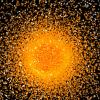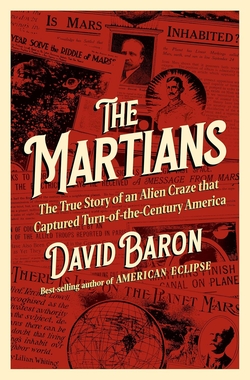Centauri Dreams
Imagining and Planning Interstellar Exploration
Ultima Thule at Highest Resolution
One of the most enjoyable interviews I’ve been involved with lately was with Ryan Ferris, who runs the podcast Cosmic Tortoise from Christchurch, New Zealand. Ryan’s questions were sharp and of a philosophic bent, plumbing issues like the purpose and direction of human exploration. From Thor Heyerdahl’s extraordinary experiments at shipbuilding and navigation to the impulses that took Polynesian sailors into unknown waters as they settled Pacific islands, is there an innate human impulse to explore? We kicked all this around, along with SETI, the ‘Oumuamua object, and the need for a re-orienting long-term approach to civilization.
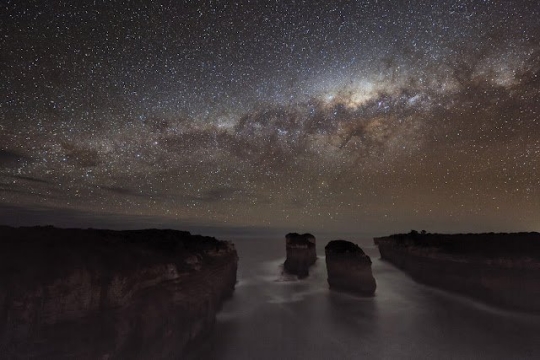
Ultima Thule and the recent exploration of it by New Horizons fit comfortably within the narrative Ryan and I discussed, as an example of satisfying that drive to push into the unknown, and also as an early marker for the growth of infrastructure in the Solar System. The Kuiper Belt pushes us hard for now, but we learn with each mission. In the meantime, forays of growing complexity to the Moon and Mars, as well as nearby asteroids, will teach us many things about human and robotic operations in ways that can extend them more frequently to system’s edge.
I’m still jazzed about Ultima Thule. The New Horizons team is saying the recently released images have the highest resolution of any the spacecraft has taken during its mission. Note the surface detail including several bright areas, roughly circular, as well as dark pits near the terminator. We’ve got so much data yet to come as New Horizons continues to return its information, so there is much to figure out at this point. “Whether these features are craters produced by impactors, sublimation pits, collapse pits, or something entirely different, is being debated in our science team,” said John Spencer, deputy project scientist from SwRI.
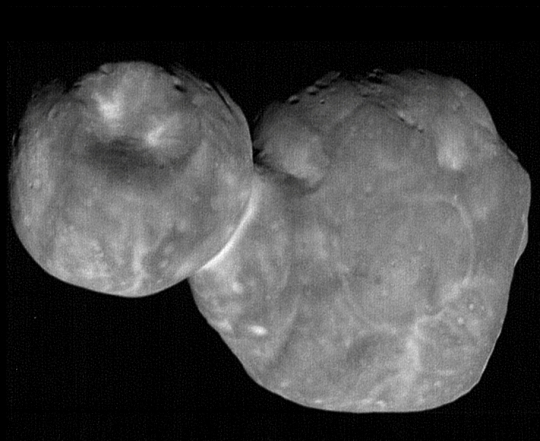
Image: The most detailed images of Ultima Thule — obtained just minutes before the spacecraft’s closest approach at 12:33 a.m. EST on Jan. 1 — have a resolution of about 33 meters (110 feet) per pixel. Their combination of higher spatial resolution and a favorable viewing geometry offer an unprecedented opportunity to investigate the surface of Ultima Thule, believed to be the most primitive object ever encountered by a spacecraft. This processed, composite picture combines nine individual images taken with the Long Range Reconnaissance Imager (LORRI), each with an exposure time of 0.025 seconds, just 6 ½ minutes before the spacecraft’s closest approach to Ultima Thule (officially named 2014 MU69). The image was taken at 5:26 UT (12:26 a.m. EST) on Jan. 1, 2019, when the spacecraft was 6,628 kilometers (4,109 miles) from Ultima Thule and 6.6 billion kilometers (4.1 billion miles) from Earth. The angle between the spacecraft, Ultima Thule and the Sun – known as the “phase angle” – was 33 degrees. Credit: NASA/Johns Hopkins Applied Physics Laboratory/Southwest Research Institute, National Optical Astronomy Observatory
The success at Ultima Thule and the possibility of another KBO encounter in an extended mission will keep New Horizons in our thoughts for a long time to come — even after its KBO adventures have ended, we’ll still be tracking a live, outbound spacecraft just as we follow the Voyagers. The degree of precision exhibited in the Ultima Thule work is made possible by the stellar occultations we’ve discussed here in past months as well as data from the European Space Agency’s Gaia mission, so critical for star locations during the occultation campaigns.
Image: New Horizons scientists created this movie from 14 different images taken by the New Horizons Long Range Reconnaissance Imager (LORRI) shortly before the spacecraft flew past the Kuiper Belt object nicknamed Ultima Thule (officially named 2014 MU69) on Jan. 1, 2019. The central frame of this sequence was taken on Jan. 1 at 5:26:54 UT (12:26 a.m. EST), when New Horizons was 6,640 kilometers (4,117 miles) from Ultima Thule, some 6.6 billion kilometers (4.1 billion miles) from Earth. Ultima Thule nearly completely fills the LORRI image and is perfectly captured in the frames, an astounding technical feat given the uncertain location of Ultima Thule and the New Horizons spacecraft flying past it at over 14.3 kilometers per second. Credit: NASA/Johns Hopkins Applied Physics Laboratory/Southwest Research Institute.
Closing to within 3,500 kilometers of its target, the spacecraft moved three times closer to Ultima than when it flew past Pluto/Charon in July of 2015. No wonder Alan Stern is exultant:
“Getting these images required us to know precisely where both tiny Ultima and New Horizons were — moment by moment – as they passed one another at over 32,000 miles per hour in the dim light of the Kuiper Belt, a billion miles beyond Pluto. This was a much tougher observation than anything we had attempted in our 2015 Pluto flyby.
“These ‘stretch goal’ observations were risky, because there was a real chance we’d only get part or even none of Ultima in the camera’s narrow field of view,” he continued. “But the science, operations and navigation teams nailed it, and the result is a field day for our science team! Some of the details we now see on Ultima Thule’s surface are unlike any object ever explored before.”
The golden age of human discovery continues; indeed, it is just beginning. If you want to explore the raw imagery from the LORRI instrument, have a look at the New Horizons LORRI website. And give some thought to context. One thing we should recall as we ponder future exploration is a vast, island-dotted Pacific, and ancestors who navigated it by wind, currents and stars.

Hayabusa2: Asteroid Touchdown
For those of you who’ve been asking, I think the best way to keep up with the Hayabusa2 mission to asteroid Ryugu is via Twitter, @haya2e_jaxa. The news continues to percolate via websites and various publications, with a sustained ripple when the spacecraft successfully tested its sample mechanism and touched down on the asteroid. I’ll remind you too that the mission team now offers updated systems information in English on its Haya2NOW page for obsessives like me who want a really fine-grained look at what’s going on.
Hayabusa 2 is once again at what JAXA calls its ‘home position’ about 20 kilometers above the asteroid as the multi-part sample selection process continues. JAXA’s news release on the touchdown was to the point:
National Research and Development Agency Japan Aerospace Exploration Agency (JAXA) executed the asteroid explorer Hayabusa2 operation to touch down the surface of the target asteroid Ryugu for sample retrieval.
Data analysis from Hayabusa2 confirms that the sequence of operation proceeded, including shooting a projectile into the asteroid to collect its sample material. The Hayabusa2 spacecraft is in nominal state. This marks the Hayabusa2 successful touchdown on Ryugu.
But really, Twitter carries the excitement of the mission via tweets like these:
[TD1-L08E1] 2/22 at 8:42 JST. The following has been confirmed at Gate 5:
?Projectile was command to fire.
?Normal sequence.
?Spacecraft state is normal.
Based on this, we determined touchdown was successful! A detailed analysis will now be done.— HAYABUSA2@JAXA (@haya2e_jaxa) February 22, 2019
and photos like the one below, which was sent out to thank worldwide supporters for their thoughts and encouragement. Look at the size of the Hayabusa2 team! Congratulations to all of you.

Upon touchdown within the 6-meter circle selected on the asteroid, the spacecraft fired a tantalum ‘bullet’ into the surface to drive particles outward that the sampling instrument could collect. The craft then rose again, as vividly attested in the photo below, where its shadow is obvious. Two more samples are to be taken before Hayabusa 2 departs the asteroid, the final sampling involving a larger crater deliberately blasted into the asteroid to probe sub-surface materials.
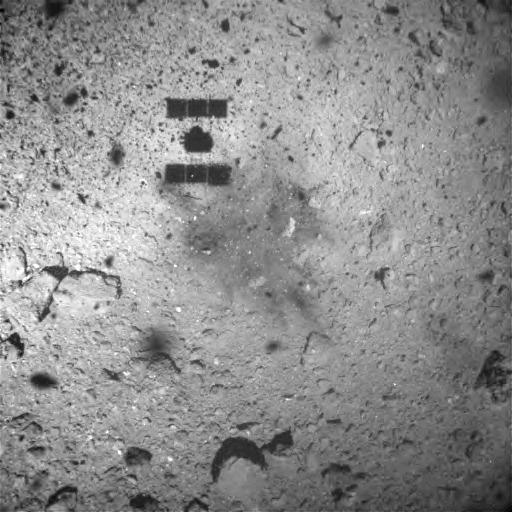
Image: Image captured roughly 1 minute after touchdown at an estimated altitude of about 25m (error is a few meter). The color of the region beneath the spacecraft’s shadow differs from the surroundings and has been discolored by the touchdown. At the moment, the reason for the discoloration is unknown but it may be due to the grit that was blown upwards by the spacecraft thrusters or bullet (projectile). The photograph was taken with the Optical Navigation Camera – Wide angle (ONC-W1) on February 22, 2019 at an onboard time of around 07:30 JST. (Credit: JAXA, University of Tokyo, Kochi University, Rikkyo University, Nagoya University, Chiba Institute of Technology, Meiji University, University of Aizu, AIST.)
You may recall that the original first sample collection was scheduled for last October, but had to be delayed because the surface of the asteroid turned out to be rougher than expected. JAXA has been operating two small robotic rovers — MASCOT and MINERVA-II — on the surface, which produced the information that centimeter-sized gravel and larger were to be found there. As the agency reported online, a key question was whether the material was fine enough be released from the asteroid during the sampling events planned, which is why an artificial gravel experiment was performed in Tokyo at the end of December.
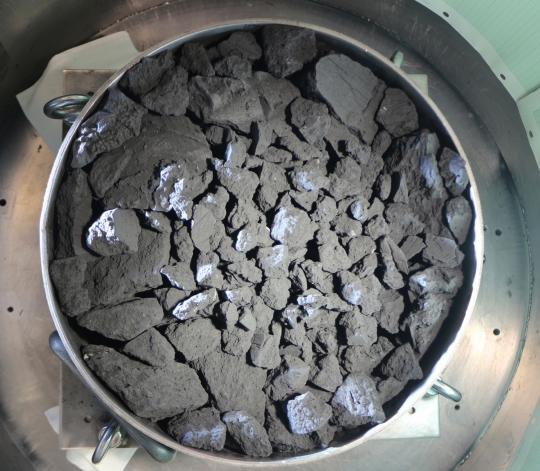
Image: Target simulating the surface of Ryugu (Credit: JAXA, University of Tokyo).
As JAXA went on to report:
In the ground test performed during the initial development, even large rocks with similar strengths to carbonaceous chondrite meteorites were crushed when a projectile made of metal (tantalum) with a mass of 5g was injected at about 300 m/s. It was confirmed that material formed from the resulting small pieces could be gathered by the sampler. So in this test, it was predictable that the bullet would crush material that it struck, but what would be the behavior of the gravel surrounding the focus of the shot?
From the results of the experiment, the fragments of gravel that were crushed were released into the surrounding gravel where they collided like billiards to break up the material. The resulting sample amount exceeded the initial assumption that would be released from the surface (Figure 4).
While the diameter of the collision site (crater) made by the impact of the projectile is smaller than when compared to that in a fine regolith layer, it was a sufficient size in comparison with the inner diameter of the open tip of the sampler horn.
The plan is for Hayabusa2 to depart Ryugu in December of this year, with return to Earth toward the end of 2020. Assuming a successful sample return, Hayabusa2 will mark the first time samples from a C-type (carbonaceous) asteroid — the most common, constituting 75% of those known — have been returned to Earth. Naturally we’ll also keep an eye on OSIRIS-REx and its operations at 101955 Bennu, another carbonaceous asteroid, for both sample returns should give us a window into early building blocks of our planet. The OSIRIS-REx sample return is scheduled for 2023.

A White Dwarf with Puzzling Rings
Backyard Worlds: Planet 9 is a project worth investigating. Using a database drawn from NASA’s Wide-field Infrared Survey Explorer (WISE), Backyard Worlds: Planet 9 is probing the cosmos at infrared wavelengths. Volunteers search the WISE data in a ‘citizen science’ effort that has already discovered more than 1,000 likely brown dwarfs. Now we have news of an intriguing white dwarf showing apparently multiple rings of gas and dust.
A ringed white dwarf isn’t unique. In fact, dust and rings have been observed around white dwarfs that were considerably younger than the one in question, J0207. As described in a paper in Astrophysical Journal Letters, the object is about 145 light years away in the constellation Triangulum and is thought to be about 3 billion years old. With a temperature of 5,800 degrees Celsius (10,500 degrees Fahrenheit), J0207 produced a strong infrared signal.
Bear in mind that a white dwarf is a remnant, a star left behind when its Sun-like predecessor, running out of nuclear fuel, has gone through red giant phase and ejected half of its mass, leaving the hot dwarf behind. As has been depicted in numerous science fiction tales, a swollen red giant can engulf its inner planets while pushing more distant planets and asteroids outward. Something of the future of our own Solar System is thus suggested.
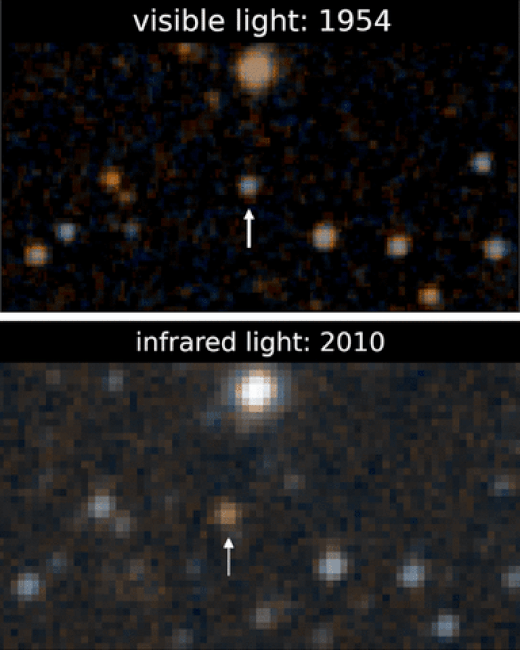
Image: Backyard Worlds: Planet 9 volunteers scour infrared images from NASA, searching animated blinks for moving objects. Like other white dwarf stars, J0207 shows a bluish tinge in visible light (top), but also sports an orange hue in the infrared (bottom), indicating the unexpected presence of circumstellar dust rings. Credit: Digitized Sky Survey/WISE/NEOWISE, Aaron Meisner (NOAO).
What made J0207 stand out for discoverer (and paper co-author) Melina Thévenot, a citizen scientist based in Germany, was infrared emission indicating the star was surrounded by a dusty disk. We could be looking at a process of tidal disruption here, in which asteroids and comets in the stellar neighborhood are brought closer to the star by gravitational interactions with surviving planets. In any case, approaching the white dwarf, they would be torn apart by the star’s gravity. The ring that emerges will eventually dissipate, spiralling down onto the surface of the star.
Having discovered something odd about J0207, Thévenot assumed there were problems with the data. Consulting the European Space Agency Gaia archives for brown dwarfs, she identified J0207, and compared it to the source in the WISE data. Its brightness and distance confirmed it was not a brown dwarf, at which point she passed her results on to Backyard Worlds: Planet 9, where Adam Schneider (ASU), John Debes (Space Telescope Science Institute), and Marc Kuchner (NASA GSFC), who leads the Backyard Worlds: Planet 9 project, could examine them.
It would be Debes and Kuchner who, working with UC-San Diego astronomer Adam Burgasser, arranged follow-up observations of J0207 with the Keck II instrument in Hawaii. What makes J0207 stand out in relation to other white dwarfs with dust disks is its age. Given a process in which asteroids are ground apart by gravitational interactions with the star, we should get to the end of the line — with all such materials incorporated into the star — in a fairly short time. This is especially true if the white dwarf is not part of a binary, which J0207 is not.
Says Debes:
“This white dwarf is so old that whatever process is feeding material into its rings must operate on billion-year time scales. Most of the models scientists have created to explain rings around white dwarfs only work well up to around 100 million years, so this star is really challenging our assumptions of how planetary systems evolve.”
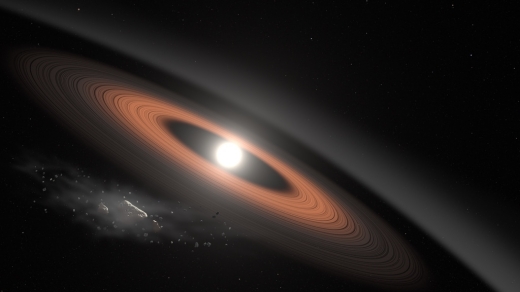
Image: The star, designated LSPM J0207+3331, is the oldest, coolest white dwarf known to be surrounded by a ring of dusty debris. This illustration depicts the ring with two distinct components, which scientists think best explains the system’s infrared signal, and an asteroid broken up by the white dwarf’s gravity. Credit: NASA Goddard Space Flight Center/Scott Wiessinger.
We may also be looking at a second point of interest, for the J0207 disk shows evidence of being composed of more than a single ring-like component. That would be a first in white dwarf observations, and for it I turn to the paper:
…the infrared excess seen for this disk requires a second, colder ring of dusty material that could potentially signal the presence of a gap in the system, or a component of dust that extends beyond the outer edge of the inner disk. If the second ring is confirmed, it would be the first example of a two-component ring system around a dusty white dwarf. If the dust disk has a gap near 0.94 R, this implies the possibility of a body that continuously clears dust from the system, since the PR drag timescale is so short.
So we have what the paper calls “an interesting test of dust disk accretion” in J0207, given the age of the star. The researchers suggest further investigation in the form of optical spectra of this white dwarf to look for metal lines from accreted dust to examine the actual accretion rate.
The paper is Debes et al., “A 3 Gyr White Dwarf with Warm Dust Discovered via the Backyard Worlds: Planet 9 Citizen Science Project,” Astrophysical Journal Letters Vol. 872, No. 2 (19 February 2019). Abstract / Preprint.
I can’t say enough how much I support Backyard Worlds: Planet 9 and other citizen science projects that are not only producing high-quality results but also involving the wider public in our ongoing exploration of the cosmos.

Finding Neptune’s Smallest Moon
What a lively place Neptune used to be, at least back in the days when the planet captured Triton, doubtless a Kuiper Belt Object now in a retrograde orbit around the primary. Recent work led by Mark Showalter (SETI Institute) puts the Hubble Space Telescope to work in studying one result of the sudden acquisition of so massive an object. A first generation of small satellites was likely scattered and rearranged, its debris becoming the Neptunian moons we see today.
Among them is Hippocamp, once known as S/2004 N 1, which appears to be a fragment from Neptune’s second largest moon Proteus. What an interesting set of observations we have here. Discovered in 2013, Hippocamp is the outermost of the planet’s inner moons, and it orbits a scant 12,000 kilometers from Proteus. We can relate the 2013 discovery with what Voyager 2 found at Neptune in 1989: A large impact crater on Proteus.
“The first thing we realised was that you wouldn’t expect to find such a tiny moon right next to Neptune’s biggest inner moon,” saysd Mark Showalter. “In 1989, we thought the crater was the end of the story. With Hubble, now we know that a little piece of Proteus got left behind and we see it today as Hippocamp.”
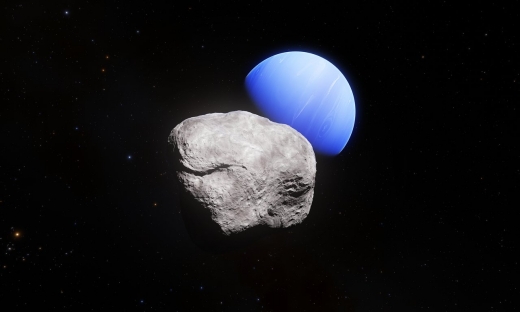
Image: This artist’s impression shows the outermost planet of the Solar System, Neptune, and its small moon Hippocamp. Hippocamp was discovered in images taken with the NASA/ESA Hubble Space Telescope. Whilst the images taken with Hubble allowed astronomers to discover the moon and also to measure its diameter, about 34 kilometres, these images do not allow us to see surface structures. Credit: ESA/Hubble, NASA, L. Calçada.
The likely cause of the Proteus impact is a comet, striking long after the havoc created by Triton’s appearance. Jack Lissauer (NASA Ames) is a co-author of the new work:
“Based on estimates of comet populations, we know that other moons in the outer Solar System have been hit by comets, smashed apart, and re-accreted multiple times. This pair of satellites provides a dramatic illustration that moons are sometimes broken apart by comets.”
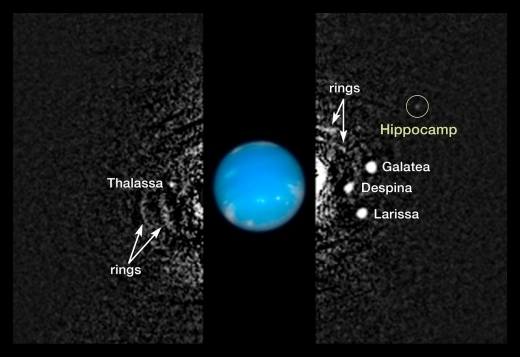
Image: This composite image shows the location of Neptune’s moon Hippocamp, formerly known just as S/2004 N 1, orbiting the giant planet Neptune, about 4.8 billion kilometres from Earth. The moon is only about 34 kilometres in diameter and dim, and was therefore missed by NASA’s Voyager 2 spacecraft cameras when the probe flew by Neptune in 1989. Several other moons that were discovered by Voyager appear in this 2009 image, along with a circumplanetary structure known as ring arcs. Mark Showalter of the SETI Institute discovered Hippocamp in July 2013 when analysing over 150 archival images of Neptune taken by Hubble from 2004 to 2009. The black-and-white image was taken in 2009 with Hubble’s Wide Field Camera 3 in visible light. Hubble took the colour inset of Neptune on August 19, 2009. Credit: NASA, ESA, and M. Showalter (SETI Institute).
Just 1/1000th the mass of Proteus, Hippocamp shouldn’t be where we see it, but that large impact crater Voyager found on Proteus tells the tale. It alone explains why Proteus didn’t assimilate or sweep aside Hippocamp long ago, thanks to an impact sufficient to have all but shattered Proteus while leaving Hippocamp behind. That cometary bombardment makes Hippocamp a third-generation satellite.
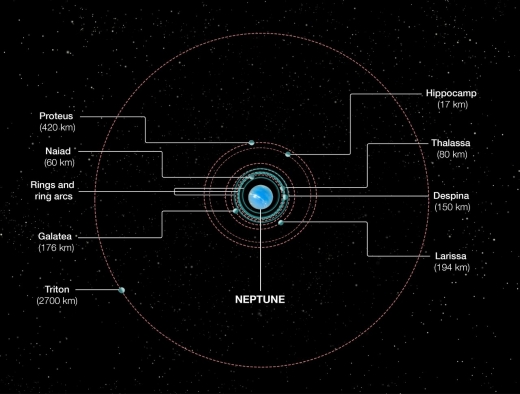
Image: This diagram shows the orbital positions of Neptune’s inner moons, which range in size from 17 to 420 kilometres in diameter. The outer moon Triton was captured from the Kuiper belt many billions of years ago. This tore apart Neptune’s original satellite system. After Triton settled into a circular orbit the debris from shattered moons re-coalesced into the second generation of inner satellites seen today. However, comet bombardment continued, leading to the birth of Hippocamp, which is a broken-off piece of Proteus. Therefore, Hippocamp is considered to be a third-generation satellite. Neither the size of the moons and Neptune, nor the orbits are to scale. Credit: NASA, ESA, and A. Feild (STScI).
Yesterday we looked at an exoplanet scenario for a massive planetary collision. The collision of Proteus with a comet is much smaller in scale, but powerful in its effects. From the paper:
We cannot rule out the possibility that Hippocamp formed in situ and has no connection to Proteus. However, its tiny size and peculiar location lead us to favour the proposed formation scenario, which illustrates the roles that collisions and orbital migration have played in shaping the Neptune system that we see today
The paper is Showalter et al., “The Seventh Inner Moon of Neptune,” Nature 566, pp. 350-353 (20 February 2019). Abstract.

Kepler 107: Collision of Worlds
It seems increasingly clear that the factors that govern what kind of a planet emerges where in a given stellar system are numerous and not always well understood. Beyond the snowline, planets draw themselves together from the ice and other volatiles available in these cold regions, so that we wind up with low-density gas or ice-giants in the outer parts of a stellar system. Sometimes. Rocky worlds are made of silicates and iron, elements that, unlike ice, can withstand the much warmer temperatures inside the snowline. But consider:
While we now have 2,000 confirmed exoplanets smaller than three Earth radii, the spread in their densities is all over the map. We’re finding that other processes must be in play, and at no insubstantial level. Low-density giant planets can turn up orbiting close to their stars. Planets not so dissimilar from Earth in terms of their radius may be found with strikingly different densities in the same system, and at no great distance from each other.
Which takes us to a new paper from Aldo S. Bonomo and Mario Damasso (Istituto Nazionale Di Astrofisica), working with an international team including astrophysicist Li Zeng (CfA). The collaboration has produced a new paper in Nature Astronomy that uses the planetary system around the star Kepler-107 to probe another possible formative influence: planetary collisions. Kepler-107 may be flagging a process that occurs in many young systems.
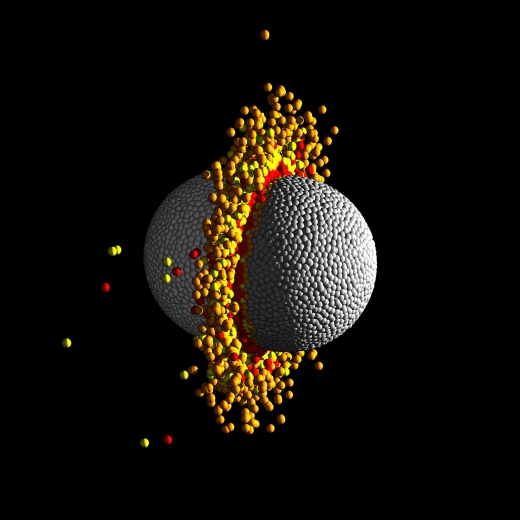
Image: The figure shows one frame from the middle of a hydrodynamical simulation of a high-speed head-on collision between two 10 Earth-mass planets. The temperature range of the material is represented by four colors grey, orange, yellow and red, where grey is the coolest and red is the hottest. Such collisions eject a large amount of the silicate mantle material leaving a high-iron content, high-density remnant planet similar to the observed characteristics of Kepler-107c. Credit: Zoe Leinhardt and Thomas Denman, University of Bristol.
Let’s take a deeper look at this curious system. The two innermost planets at Kepler-107 have radii that are nearly identical — 1.536 and 1.597 Earth-radii, respectively. They both orbit close to the host, a G2 star in Cygnus of about 1.25 solar masses, with orbital periods of 3.18 and 4.90 days. The scientists used the HARPS-N spectrograph at the Telescopio Nazionale Galileo in La Palma to determine the planets’ masses, and because they were working with known radii (thanks to Kepler’s observations of these transiting worlds), they were able to determine their densities. And now things get interesting.
For the innermost planet shows a density of 5.3 grams per cubic centimeter, while the second world comes in at 12.65 grams per cubic centimeter. The inner world, Kepler-107b, is thus about the same density as the Earth (5.5 grams per cubic centimeter), while Kepler-107c shows a much higher number (for comparison, water’s density is 1 gram per cubic centimeter).
The outer of the two is the denser world and by more than twice the inner world’s value, and given the proximity of their orbits, coming up with stellar radiation effects that could have caused mass loss is difficult to do, for such radiation should have affected both in the same way. The remaining strong possibility is that a collision between planets played a role in this system.
“This is one out of many interesting exoplanet systems that the Kepler space telescope has discovered and characterized,” says Li Zeng. “This discovery has confirmed earlier theoretical work suggesting that giant impact between planets has played a role during planet formation. The TESS mission is expected to find more of such examples.”
And this from the paper, which notes the possibility of extreme X-ray and ultraviolet flux in the young system, but dismisses it as operational here, at least to explain the discrepancy:
This imbalance cannot be explained by the stellar XUV irradiation, which would conversely make the more-irradiated and less-massive planet Kepler-107b denser than Kepler-107c. Instead, the dissimilar densities are consistent with a giant impact event on Kepler-107c that would have stripped off part of its silicate mantle.
Image: The video shows a hydrodynamical simulation of a high-speed head-on collision between two 10 Earth-mass planets. The temperature range of the material is represented by four colors grey, orange, yellow and red, where grey is the coolest and red is the hottest. Watch Video. Credit: Zoe Leinhardt and Thomas Denman, University of Bristol.
We can produce Kepler-107c, then, by a collision that results in a high-density remnant. We have apparent evidence for collisions even in our own Solar System. The composition of Mercury, with a dense metallic core and thin crust, may point to this; only Earth is more dense in our system. So too could the emergence of Earth’s moon through a planetary-sized impactor striking our planet. We can also see in the obliquity of Uranus — the planet’s axis of rotation is skewed by 98 degrees from what we would expect — the possibility that, as advanced in some theories, a large object struck the planet long ago.
The paper gives us some of the details about Kepler 107:
…the difference in density of the two inner planets can be explained by a giant impact on Kepler-107 c that removed part of its mantle, significantly reducing its fraction of silicates with respect to an Earth-like composition. The radius and mass of Kepler-107 c, indeed, lie on the empirically derived collisional mantle stripping curve for differentiated rocky/iron planets… Smoothed particle hydrodynamics simulations show that a head-on high-speed giant impact between two ~10M? exoplanets in the disruption regime would result in a planet-like Kepler-107 c with approximately the same mass and interior composition… Such an impact may destabilize the current resonant configuration of Kepler-107 and thus it likely occurred before the system reached resonance. Multiple less-energetic collisions may also lead to a similar outcome.
Another possibility discussed by the authors: Planet c may have formed closer to the parent star and later crossed Kepler-107b in its orbit. But the authors note that to dampen the orbital eccentricities this would have produced, this scenario is unlikely to have had time to operate.
The paper is Bonomo & Zeng, “A giant impact as the likely origin of different twins in the Kepler-107 exoplanet system,” Nature Astronomy 04 February 2019 (abstract).

Gravitational Wave Astronomy: Enter the ‘Standard Siren’
Recently we’ve talked about ‘standard candles,’ these being understood as objects in the sky about which we know the total luminosity because of some innate characteristic. Thus the Type 1a supernova, produced in a binary star system as material from a red giant falls onto a white dwarf, causing the smaller star to reach a mass limit and explode. These explosions reach roughly the same peak brightness, allowing astronomers to calculate their distance.
Even better known are Cepheid variables, stars whose luminosity and variable pulsation period are linked, so we can measure the pulsation and know the true luminosity. This in turn lets us calculate the distance to the star by comparing what we see against the known true luminosity.
This is helpful stuff, and Edwin Hubble used Cepheids in making the calculations that helped him figure out the distance between the Milky Way and Andromeda, which in turn put us on the road to understanding that Andromeda was not a nebula but a galaxy. Hubble’s early distance estimates were low, but we now know that Andromeda is 2.5 million light years away.
I love distance comparisons and just ran across this one in Richard Gott’s The Cosmic Web: “If our galaxy were the size of a standard dinner plate (10 inches across), the Andromeda Galaxy (M31) would be another dinner plate 21 feet away.”
Galaxies of hundreds of billions of stars each, reduced to the size of dinner plates and a scant 21 feet apart… Hubble would go on to study galactic redshifts enroute to determining that the universe is expanding. He would produce the Hubble Constant as a measure of the rate of expansion, and that controversial figure takes us into the realm of today’s article.
For we’re moving into the exciting world of gravitational wave astronomy, and a paper in Physical Review Letters now tells us that a new standard candle is emerging. Using it, we may be able to refine the value of the Hubble Constant (H0), the present rate of expansion of the cosmos. This would be helpful indeed because right now, the value of the constant is not absolutely pinned down. Hubble’s initial take was on the high side, and controversy has continued as different methodologies yield different values for H0.
Hiranya Peiris (University College London) is a co-author on the paper on this work:
“The Hubble Constant is one of the most important numbers in cosmology because it is essential for estimating the curvature of space and the age of the universe, as well as exploring its fate.
“We can measure the Hubble Constant by using two methods – one observing Cepheid stars and supernovae in the local universe, and a second using measurements of cosmic background radiation from the early universe – but these methods don’t give the same values, which means our standard cosmological model might be flawed.”
Binary neutron stars appear to offer a solution. As they spiral towards each other before colliding, they produce powerful gravitational waves, ripples in spacetime, that can be flagged by gravitational experiments like the Laser Interferometer Gravitational Wave Observatory (LIGO) and Virgo. Astronomers can then compare the gravitational wave observation with the detected light of a binary neutron star merger, a result that produces the velocity of the system
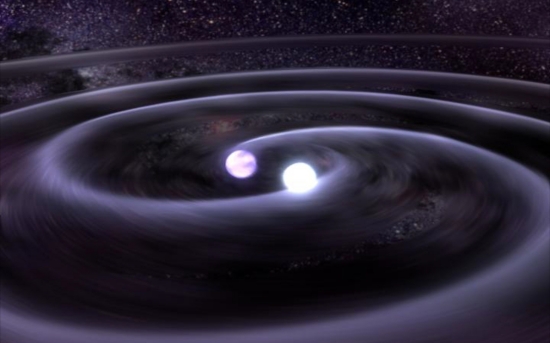
Image: Artist’s vision of the death spiral of the remarkable J0806 system. Credit: NASA/Tod Strohmayer (GSFC)/Dana Berry (Chandra X-Ray Observatory).
We’re closing on a refined Hubble’s Constant, and researchers on the case, led by Stephen Feeney (Center for Computational Astrophysics at the Flatiron Institute, NY) think that observations of no more than 50 binary neutron stars should produce sufficient data to pin down H0. We’ll then have an independent measurement of this critical figure. And, says Feeney, “[w]e should be able to detect enough mergers to answer this question within 5-10 years.”
Nailing down the Hubble Constant will refine our estimates of the curvature of space and the age of the universe. Just a few years ago, who would have thought we’d be doing this by using neutron star interactions as what the researchers are now delightfully calling ‘standard sirens,’ allowing measurements that should solve the H0 discrepancy once and for all.
A final impulse takes me back to Hubble himself. The man had a bit of the poet in him, as witness his own outside perspective of our galaxy: “Our stellar system is a swarm of stars isolated in space. It drifts through the universe as a swarm of bees drifts through the summer air.” Found in The Realm of the Nebulae (1936).
The paper is Feeney et al., “Prospects for Resolving the Hubble Constant Tension with Standard Sirens,” Physical Review Letters 122 (14 February 2019), 061105 (abstract).

